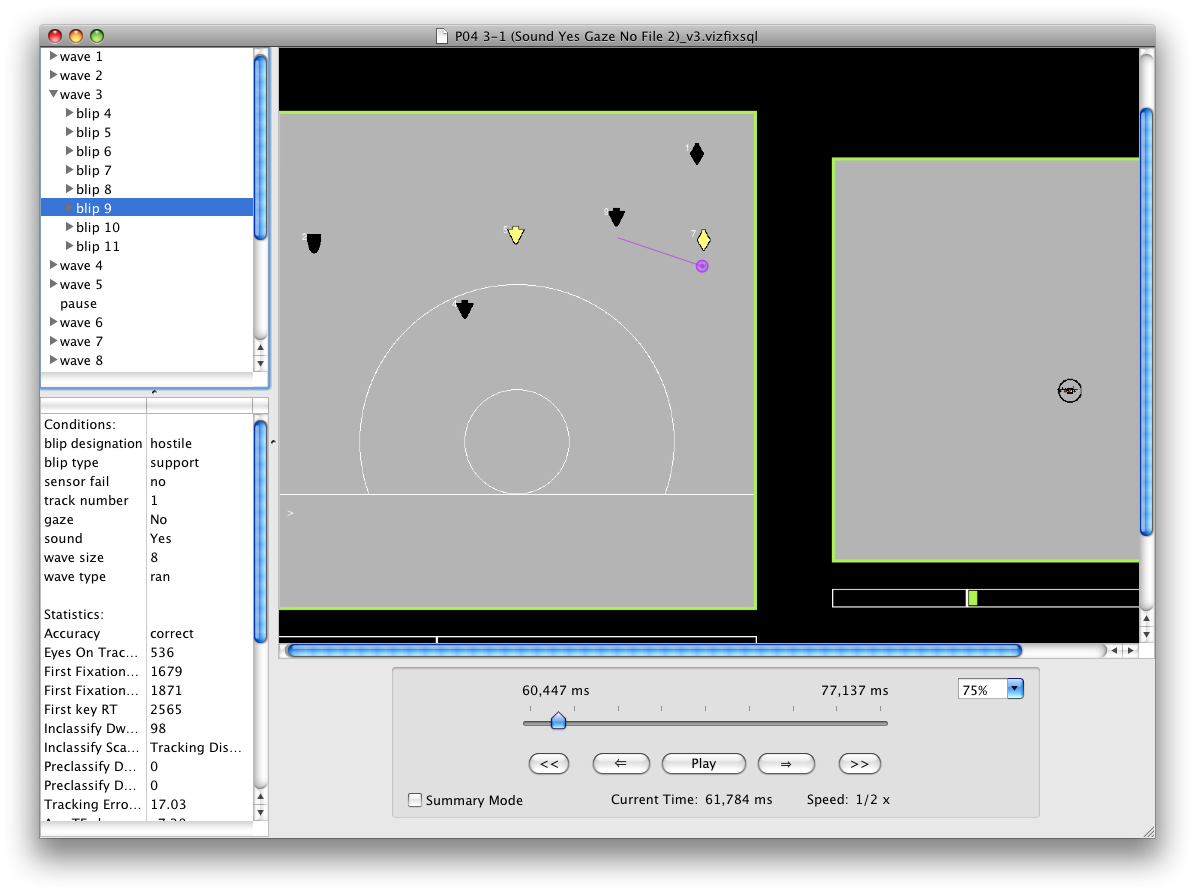 Screenshot of VizFix
Screenshot of VizFix
VizFix is a research tool for visualizing gaze fixations and other data from eye tracking experiments. VizFix can replay an experimental session with real-time eye movement data superimposed on the display. It can also provide a summary visualization for the data within a period of time. VizFix provides facilities for defining regions of interests and collecting a range of statistics from eye movement data.
VizFix is developed at the University of Oregon Cognitive Modeling and Eye Tracking Laboratory . It has been revised several times in order to make it adaptable to many different eye tracking experiments. For example, VizFix v1.0 was adapted to a multimodal multitasking experiment, in which the visual stimuli can appear at any locations and move.
VizFix is not bound to a particular brand of eye tracker. Instead, it depends on the experimental data format that is output by the human data collection software. VizFix v0.2 works with data generated from a visual search experiment that was carried out on an LC Technologies eye tracker. VizFix v1.0 works with a multimodal experiment that was also carried out on the LC system. VizFix 1.0 also works with data generated by the experimental data collection software "E-Prime Extension for Tobii", which relies on Tobii eye trackers; VizFix 1.0 accomplishes this through a data importing tool (see below).
Principle Investigator:
Anthony Hornof.
Chief Designers and Programmers: Tim Halverson (v0.2), Yunfeng Zhang (v1.0).
The current version is developed using Objective-C and Apple's Cocoa framework. The program includes two parts: a visualization program and a framework which supports developing extension programs. Extension programs usually do two types of work: either translating the experimental logs into VizFix data format or analyzing VizFix eye movement data. In this way, the visualization program can work with many eye tracking experiments without any modification. More detailed description of VizFix can be found in the manual.
Download VizFix 1.0 and Manual.
Requires Mac OS X 10.5 or above.
Download the source code
or access the repository on
Google Code.
Note: This version supports the mean shift eye movement error correction technique introduced in Zhang and Hornof (2010). The previous version 0.2 (below) implements the other error correction method—the Required Fixation Location Technique.
An extension program, EPImport, has been developed for translating eye movement data generated by E-Prime Extension for Tobii into VizFix data format. The extension program is intended to be used with VizFix 1.0. Since it's still in early development, the importing tool has several limitations (see the tutorial).
Download EPImport and Tutorial.
Requires VizFix 1.0.
Download the source code
or access the repository
here.
VizFix 0.2 is developed in 2002. It is written in C++ using Metrowerks CodeWarrior. This version implements an eye movement error correction method, the Required Fixation Locations technique, which is introduced in Hornof and Halverson (2002).
Download VizFix 0.2 and sample data.
Runs on Macintosh OS 9 and OS X.
Download all data.
Download the source code.
(Open with Metrowerks CodeWarrior.)
Download the software requirements specification (PDF).
View the class UML diagram.
Hornof, A. J., & Halverson, T. (2002). Cleaning up systematic error in eye tracking data by using required fixation locations. Behavior Research Methods, Instruments, and Computers, 34(4), 592-604. Available as a PDF file.
Zhang, Y., & Hornof, A. J. (2010). Using the mean shift algorithm to make post hoc improvements to the accuracy of eye tracking data based on probable fixation locations. Department of CIS Technical Report 2010-04, University of Oregon. Available as a PDF file.
July 15, 2010 by Yunfeng Zhang